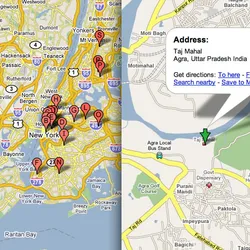Scott Lederer

Google Maps
Redesigning local search for a global audience
2008–2011, 2014
During my tenure as Local Search UX Designer for Google Maps, I helped transform how billions of users discover, research, and compare places.
Shaping Local Search UI: I contributed to every facet of the local search experience across Maps. This included redesigning:
- Search Results: Endlessly refining the sidebar experience for ease of comparison.
- Info Bubbles: Streamlining map info bubbles for quick access to key details.
- Place Pages: Creating a centralized page for every place on Earth, with rich details like reviews, photos, and web search results. This was the culmination of a massive investment in transforming our entire geographic information paradigm from web content aggregation to an entity-centric model.
Unpacking Local Search Use Cases: When I started, Google Maps was focused on two primary use cases: categorical search (e.g., "Find pizza places") and navigational search (e.g., "Show me details about John's Pizza"). But hiding within and around those generic use cases was a wealth of nuance we were overlooking. Partnering with researchers and fellow designers, I helped identify and develop more refined search scenarios.
We unpacked categorical search into distinct patterns, such as:
- Commodity Search: "Any convenience store will do.”
- Sufficient Search: "A decent meal nearby."
- Goldilocks Search: "The perfect spot for an anniversary."
And we identified variants of navigational search like:
- Whatchamacallit Search: "What was that campground we visited last year?"
- Chainagational Search: "Show me the nearest Wawa."
- Kleenex Search: "Find a Home Depot, but Lowes is also fine."
We evangelized these nuanced use cases across the organization, integrating them into our everyday lingo and embedding them into our designs to better meet the evolving needs of users around the world with ever-increasing digital literacy.
Pioneering Mobile Local Search: As the mobile revolution took off, I designed a concierge-like mobile experience for discovering local restaurants and venues. This concept later evolved into the Explore feature of Google Maps for Android, which launched after my departure.
Company-Wide 5-star Ratings Redesign: A memorable project involved redesigning Google’s rating stars system, which, at the time, varied across products in terms of icons, colors, language, and behavior. I spearheaded the design effort for a cohesive ratings experience, standardizing the UI across Google products, many aspects of which remained in place for years.

